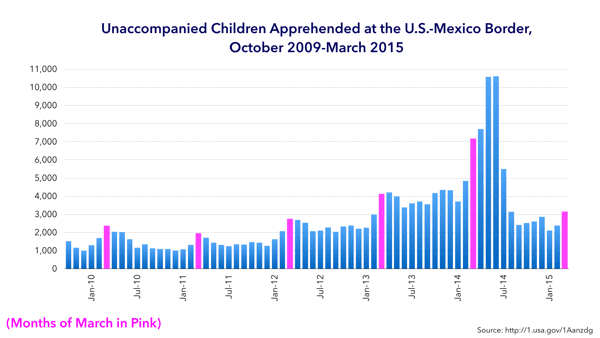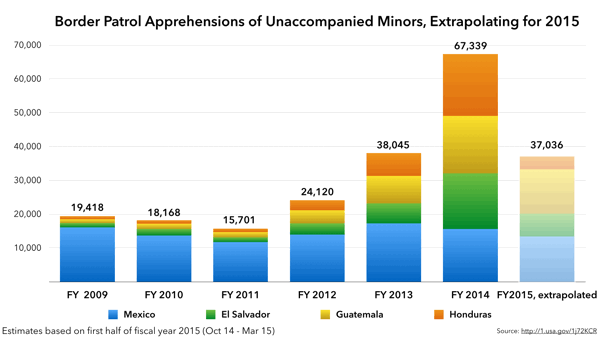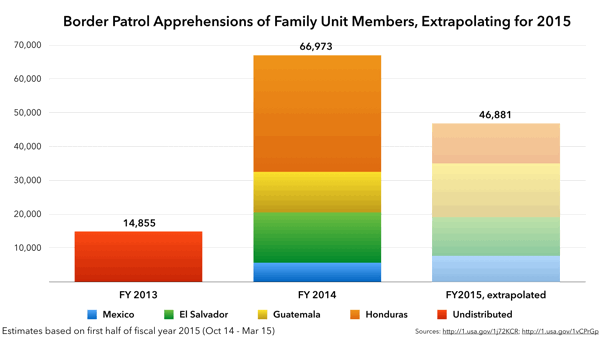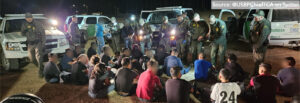In March, U.S. Border Patrol apprehended 3,138 unaccompanied children on the U.S. side of the border with Mexico. Of that number, 1,070 kids were Mexican citizens. 579 were from El Salvador, 1,084 were from Guatemala, and 368 were from Honduras.
3,138 children crossing a border without a parent sounds like a very high number—and by historic standards, it is—yet it is less than half the 7,176 unaccompanied children whom Border Patrol reported apprehending in March 2014.
That month marked the start of an unprecedented wave of children and families, most of them from El Salvador, Guatemala, and Honduras, that got heavy U.S. media attention in May and June 2014, with heartbreaking images of kids crammed into U.S. detention centers. During the U.S. government’s 2014 fiscal year (“FY,” or October 2013-September 2014), U.S. authorities ended up detaining more than 67,000 unaccompanied children, and another 67,000 children and parents, from Mexico and Central America.
That crisis subsided almost as quickly as it began, with Border Patrol apprehensions of unaccompanied children falling back to 2013 levels by August 2014. The crisis subsided, that is, but it is not over. While reduced from the mid-2014 spike, the number of children and families migrating to the United States remains higher than has been measured at any other time.
Because of better weather, March usually is a month of increased migration to the United States. It happened again this year, as Border Patrol apprehended 32 percent more unaccompanied children than it did in February. Nonetheless, that is actually the smallest February-to-March increase of the past six years:
- March 2015: 3,138 unaccompanied children apprehended, up 32% over February
- March 2014: 7,176, up 48%
- March 2013: 4,120, up 38%
- March 2012: 2,755, up 33%
- March 2011: 1,956, up 49%
- March 2010: 2,364, up 39%
As a result, U.S. officials are predicting an even smaller number of unaccompanied children by the end of the year than originally expected. Gil Kerlikowske, the commissioner of U.S. Customs and Border Protection (CBP), said on April 8 that he expects arrivals of unaccompanied children to drop “down to the levels of FY 2012,” when Border Patrol apprehended 24,120 children, most of them from Mexico.
That estimate sounds too low. Border Patrol already apprehended almost two-thirds that many children during the first half of FY 2015 (15,647), and several of the heaviest months of migration (April through July) still lie ahead.
During the first quarter of FY 2015 (October-December 2014), Border Patrol reported apprehending 38 percent fewer unaccompanied minors than during the same period a year earlier. That set 2015 on a pace to reach 41,750 apprehensions, the second-highest number ever, well ahead of the 38,045 apprehensions registered in FY 2013.
Now that the first half of FY 2015 is over, Border Patrol is reporting a 45 percent reduction compared to the first half of FY 2014. That lowers our projection for 2015 to 37,036 unaccompanied minors—about the same as FY 2013, but well ahead of Commissioner Kerlikowske’s projection of about 24,000 kids.
Here is the math underlying the CBP Commissioner’s prediction. Unaccompanied child apprehensions dropped 38 percent in the first quarter of 2015 compared to the first quarter of 2014. The second quarter of 2015 was a remarkable 51 percent lower than the second quarter of 2014. If those reductions were to continue to accelerate at that same +13% per quarter rate — 64 percent fewer in the third quarter and 77 percent fewer in the fourth quarter—then the 2015 total could come to 27,000. But we believe that such radical reductions are too much to assume.
Meanwhile, apprehensions of family unit members—children traveling with at least one parent—have not dropped as steeply: 30 percent fewer in the first half of FY 2015 compared to the first half of FY 2014. A 30 percent drop from 2014 would give us a projection of 46,881 family unit members apprehended in FY 2015—the second-highest total on record. While child and family migration is no longer at overwhelming, emergency levels, it remains at historic highs.
The poverty and violence driving young Central Americans to migrate haven’t improved in the past year. What, then, caused the drop in child and family migration after July 2014? Our hypothesis is that Mexico’s crackdown on Central American migrants is the main reason.
Starting around that time, with significant U.S. support, Mexico’s government started implementing a “Southern Border Plan,” which it bills as an effort to improve security and development in areas bordering Guatemala and Belize. So far, the Southern Border Plan’s most visible component has been its security effort. Police and immigration agents are preventing Central American migrants from riding atop cargo trains in the southern border states of Chiapas and Tabasco. They have increased patrols to search for undocumented migrants, and set up new vehicle checkpoints on roads.
As WOLA noted in early April, Mexican government statistics show a huge jump in the number of Central Americans being deported back to their countries. The January-February 2015 figure was roughly double that of January-February 2014.
Further evidence that the Southern Border Plan is the main factor lies in the U.S. government’s statistics. So far this year, U.S. Border Patrol reports a sharp drop in apprehensions of unaccompanied children and family unit members from El Salvador (-59% and -22%, respectively) and Honduras (-80% and -65%, respectively) compared to the first half of 2014.
However, Border Patrol has apprehended only 15 percent fewer unaccompanied Mexican children, and 35 percent more Mexican family-unit members. Any improvements to U.S. border security have not deterred Mexican migrants, whose journey of course would be unaffected by Mexico’s Southern Border Plan.
Interestingly, the number of Guatemalans apprehended in the United States has only gone down modestly this year. Border Patrol apprehensions of unaccompanied Guatemalan children are down 23 percent, a much smaller decrease than El Salvador and Honduras, while apprehensions of Guatemalan family unit members are up 32 percent. Perhaps because being deported from Chiapas across the border into adjacent Guatemala is an inconvenience but not a journey-ending event, Mexico’s Southern Border Plan is not having the same deterrent effect.
In mid-2015, WOLA staff will carry out field research in southern Mexico to test this hypothesis. We have a lot of questions about whether the Southern Border Plan is being carried out in a way that respects human rights. Information is incomplete, but we are seeing recent denunciations from migrant rights defenders in the region that authorities allowed a migrant they were pursuing to drown in a river, and set fire to pastures where migrants were believed to be hiding.
We are also concerned about the Southern Border plan’s effects on Central Americans who may be migrating out of a genuine fear for their lives. Since it is very difficult for Central Americans to apply for asylum in Mexico, the Southern Border Plan may be sending hundreds, or thousands, of people right back to the domestic violence or specific threats that they were seeking to escape. The humanitarian consequences could be severe.
And of course, Mexico’s crackdown on migration doesn’t resolve the reasons why Central Americans are migrating. It makes migration more difficult, and probably enriches smugglers in the process. But we predict that it is only a matter of time before migrants, and migrant smugglers, adapt to the Southern Border Plan’s measures. Migration routes will shift in response to the crackdown. Mexican and Central American media are already reporting on Central American migrants taking more dangerous routes: walking long distances to board cargo trains north of Chiapas, and even taking rafts up the Pacific to get past the crackdown zone.
We will continue to report on all of this as we learn more.




